Madrid sightseeing plan - map, tickets, attractions, monuments, accommodation, interesting facts
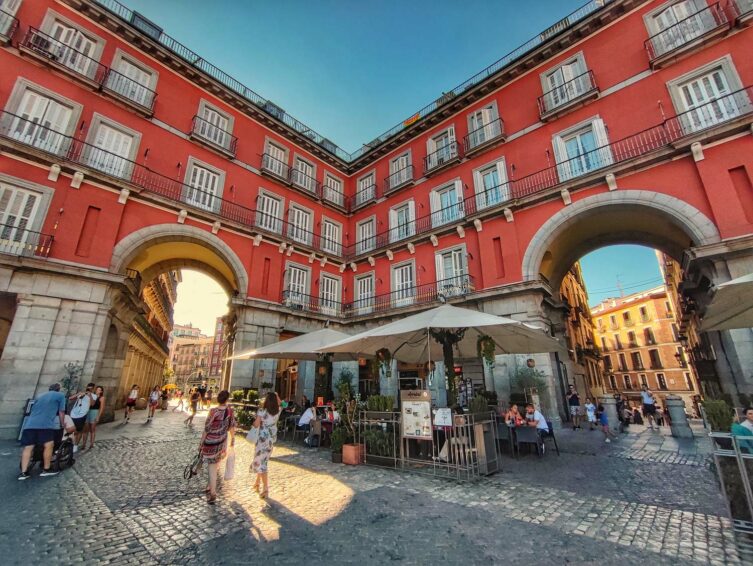
royal city
In Madrid, everything is regal, with regal momentum and size. What immediately catches the eye is the attention to the appearance of facades, streets and squares, visible at every step. Many streets look as if they have just been renovated, and as many are currently under renovation, undergoing thorough beautification. It is difficult for me to point to a city where so many huge tenement houses, whole streets or even quarters would look like in Madrid: freshly renovated and recently painted. Roofs that are supposed to have a specific color have that color. The gilding of the buildings sparkles with gold, and the white or pastel facades are actually white or pastel. Everything royal.
The royal character of the city can be seen at every step and I admit that I needed a moment to get used to it. This momentum makes you feel a little overwhelmed. It's a little harder to find a cozy corner here, where you can snuggle up unnoticed. A large palace, wide streets, large tenement houses, a large park ... and I am so small. With time, however, it turned out that if you look closely, you can find your own corner, your niche in Madrid, and there are not so few of them. You have to give Madrid time to get to know it first and then make friends. This is how I constructed my sightseeing itinerary: to get to know Madrid a little better first, and then to turn this closer acquaintance into true friendship.
During the tour, we will walk through the royal alleys, touch high art, then squeeze into narrow alleys and eat the world's best street food, served in iconic places. We will not miss the legendary restaurants featured in culinary programs and the old pastry shops that have been present here for generations. In the end (I hope) it will turn out that Madrid is a really nice city.
Madrid sightseeing itinerary
Even though Madrid is a huge city, visiting it is quite simple and pleasant. Most of the monuments and places of interest are located near the very center and the distances between them are such that they can be covered on foot. In addition, the city has a dense network of metro stations and even when you run out of energy, you can continue exploring by taking the metro almost everywhere.
To make it easier, I have prepared a special map with all the interesting attractions of Madrid and a few selected metro stations (those located near key sightseeing points).
Take a moment to look at the map below:
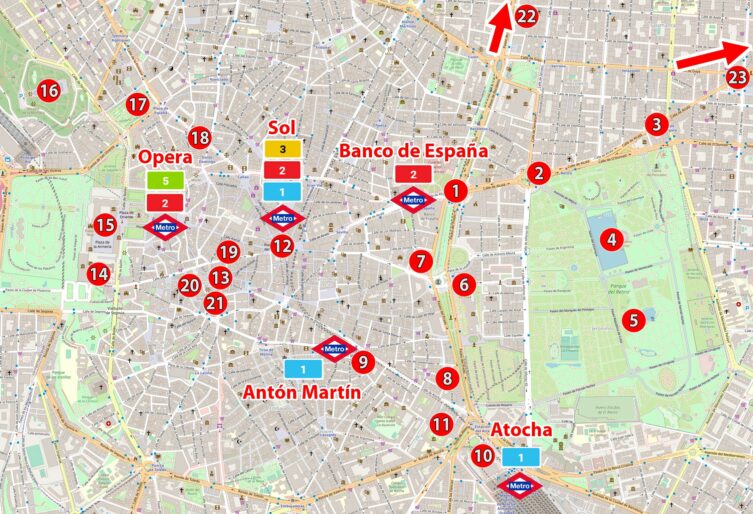
Each of the attractions I have marked has its own number and each of them, under the number assigned to it, has been briefly described in the further part of the text. The numbers you see in the table of contents at the beginning of the article correspond exactly to the numbers on the map.
At the markers of the metro station, I also provided its name and the numbers and colors of the lines that stop at it.
These few basic data should make it much easier for you to orientate yourself in the area and build your own sightseeing plan.
Of course, I've also prepared my own proposal for exploring Madrid, so if you don't want to create your own itinerary, just read on. I'm going to tell you my plan in a moment, and I'm going to throw in some really useful information.
First, however, before we go into the details of the step-by-step tour, in four words I would like to draw your attention to two very important issues. Both can make your sightseeing experience much easier and more enjoyable, or turn the whole plan upside down.
The case concerns: GPS coordinates and entrance tickets to attractions.
Use GPS coordinates!
For each attraction, I give precise information GPS coordinatesthat will allow you to always reach your destination. Just go to this page on your phone, click on the link next to the coordinates of the attraction and the navigation application will automatically open.
And it's not about going exactly as the navigation shows! Just walk towards the selected point of the tour through the streets you feel like walking. Treat navigation on your phone rather as information whether you are going in the right direction and approaching your goal, or whether your fantasy is already taking you in the wrong direction 🙂
When you reach one point of the trip and want to go further, you click on the coordinates of the next point and from point to point you can freely explore Madrid on your own, as if you had lived here all your life.
Entrance tickets to attractions in Madrid
Of course, a well-thought-out sightseeing plan is important, but the entrance tickets to attractions are absolutely the most important. Even the most perfect plan will fall to pieces when it suddenly turns out that you have to spend 2 hours in the queue for tickets before entering, and the next free place to enter is in another hour.
This is exactly what I had in Madrid at the Reina Sofía Museum. The huge square in front of the museum was literally crowded with people waiting in line to enter. I had the choice of standing in the line for a ticket for who knows how long and blowing up the rest of the day, or moving on and giving up entry. Finally, I gave up the entrance and went to explore what I had planned for the rest of the day. I had to wait four years for the chance to come back to Madrid and enter the Reina Sofía Museum…
Constructing every plan you need to start by checking the availability of tickets for the day and time you are interested in. The assumption that you go blind and look for tickets on the spot is pointless. Nerves, frustration and wasted time are then guaranteed. Popular attractions in the season are always very crowded and it is worth booking your entrance in advance. Forget you'll be able to walk in!
Fortunately, for some time the sale of tickets to the most crowded places has been carried out via the Internet. The ticket is usually bought for a specific day and time. Then you just come to the place at the indicated time and go inside without a queue. Most often, for tourists who have purchased tickets in advance, there is a separate entrance, so that they do not have to squeeze through the waiting queue.
In my opinion, wherever it is possible to purchase tickets via the Internet, you must do so.
Sometimes an additional handling fee is added to the price of the online ticket (these are surcharges around single EUR), but if someone asks me if I prefer to wait in line for a ticket for several hours, or maybe it is better to pay extra EUR 2 and enter without a queue, the answer seems to be straight.
Of course, not everywhere such a surcharge is added and many venues sell tickets online at the same price as at the cash desk, but it is worth knowing that this practice is sometimes encountered.
Finishing the topic of tickets, for each attraction (if possible) I will try to provide a link to the page where you can buy admission tickets to it. I assume that such a simplification may be very useful for you.
WARNING!
If the ticket page opens in a language that is inconvenient for you, you can change the language of the page at any time (Polish is also available!). The language selection is at the bottom or top of the page (depending on whether you are accessing the page on your phone or computer).
Madrid - a detailed sightseeing itinerary
First, take another look at the attractions map. This time, with small red dots, I marked the approximate route of the walk, which combines all the attractions visible on the map into a sensible sightseeing plan.
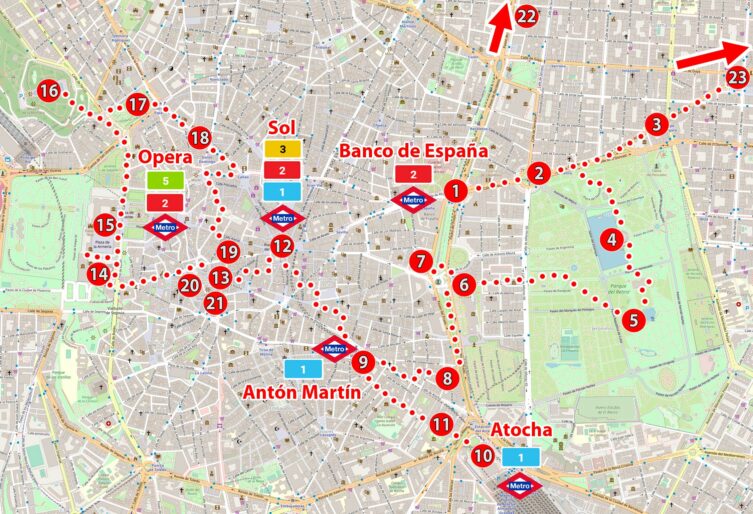
I bet your first impression is like this is an itinerary that allows you to visit Madrid in one day. In practice, the system proposed by me gives much more possibilities. It was prepared by me in such a way that it can be divided into independent elements that can be visited on separate days, in any order.
The most natural division is a plan for two days. The first day consists of numbers from 1 to 9, while day two are the numbers from 10 to 21.
Numbers 22 and 23 are reserved for two stadiums: the stadium Real Madrid (22) and Atletico Madrid (23). Both stadiums can be visited! They are located a little further from the city center and need to be reached by subway. Details of how to get there can be found in the further part of the text, and I leave the decision on which day to visit them. Add them to the plan wherever you want.
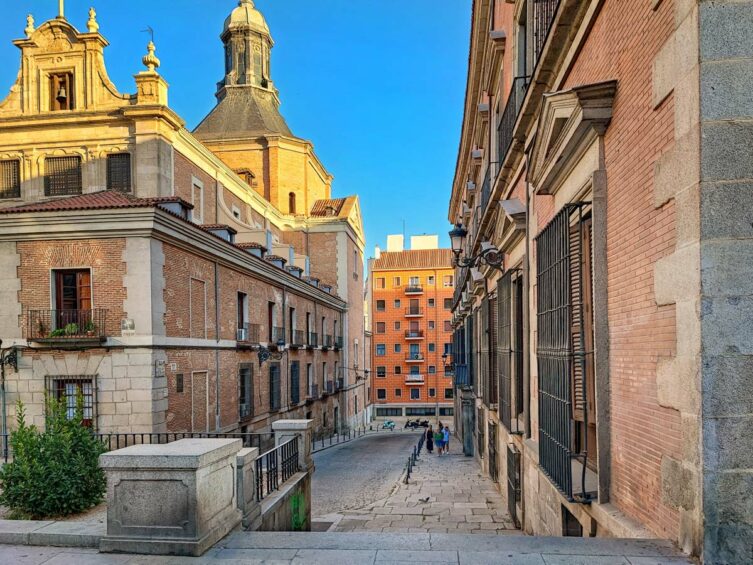
Madrid - sightseeing in two days
At the beginning, I will present a proposal to visit Madrid in two days (the plan for one day can be found in the further part of the text). It seems that two days to get to know the capital of Spain is a good plan. On the one hand, it gives you enough time to complete everything you need to feel the city well, and on the other hand, both days are filled to the brim. Such a plan is also easy to fit into a typical “city break”, for which we usually have two days.
In Madrid, apart from the attractions typical of large cities (squares, streets, buildings, parks .... etc.), there are three fantastic art museums. All three are really big and have brilliant harvests. Iconic works by Pablo Picasso, Vincent van Gogh, El Greco, Titian, Caravaggio, Francisco Goya, Albrecht Dürer should be seen by everyone in the original. Giving up any of these museums is a huge loss, but going to all three in one day is pointless. They are just too big and need to be split over two days. That's how they were placed in my plan.
In addition, each day's plan takes into account culinary needs and during the walk and at its end we reach places where you can try excellent, diverse, street food and affordable.
Sightseeing in Madrid - day one
For starters, I'm posting a walking map for the first day. This is exactly the same map I've posted before, but limited to the walking area only.
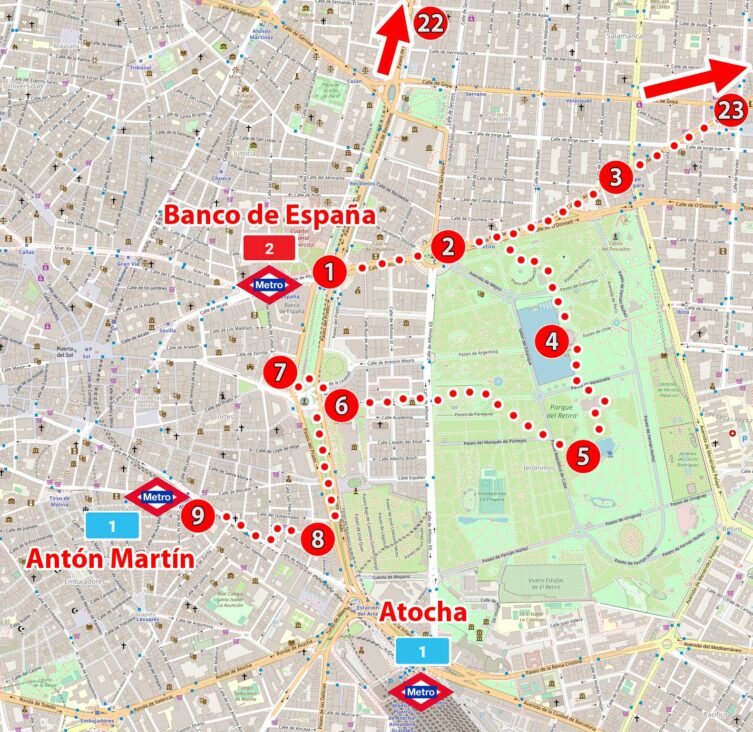
1. Plaza de Cibeles
2. Puerta de Alcala
3. Calle de Alcala
4. Retiro Park
5. Crystal Palace
6. Prado Museum
7. Thyssen-Bornemisza Museum
8. Jardin Vertical Caixaforum
9. Mercado Anton Martin
map base: openstreet.org
The walking route marked by me is only a loose proposal. You don't have to hold onto it tightly. Walk the streets that you find attractive and give yourself some freedom. Use GPS coordinates for casual walks. Such freedom of sightseeing gives a lot of comfort and a lot of pleasure from getting to know the city.
Route length: 5 km
Time of transition (without attraction time): 1 hour 30 minutes
The course of the route: Banco de Espana Metro Station - Plaza de Cibeles (Palacio de Comunicaciones, Cybele Fountain) - Puerta de Alcala - Calle de Alcala - Retiro Park - Crystal Palace - Prado Museum - Thyssen Bornemisza Museum - Caixaforum Vertical Garden - Mercado Antón Martín - Station Anton Martin subway
You can also open the walking route in the form active Google map - [click]
The route is only 5 km and seems short. However, keep in mind that it goes through a huge park where you'll probably want to spend some time, and there are two more museums on the agenda. At the end you will reach MErcado Anton Martin. This is one of the iconic, covered bazaars, where fresh, tasty and relatively inexpensive food from around the world is served. Here everyone will find something for themselves. There is a lot to choose from, there is a place to sit and there is also something to drink.
1. Plaza de Cibeles (Palacio de Comunicaciones, Fountain of Cybele)
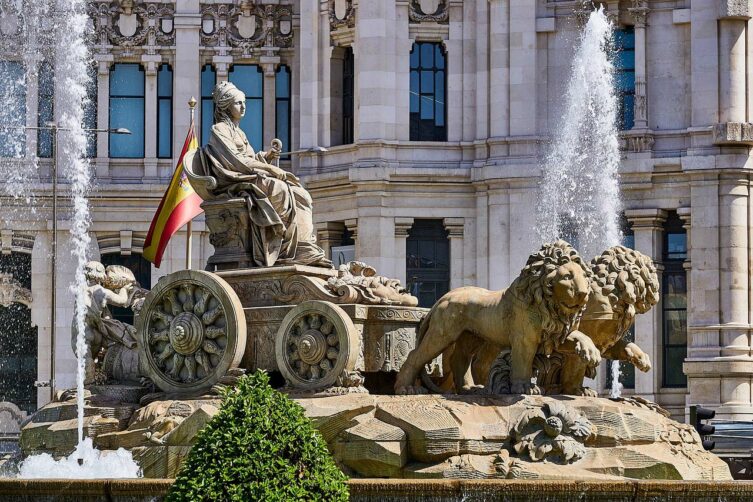
What happens when Real Madrid wins the Champions League or Spain wins the World Cup? The fiesta begins in Madrid. The center of the fiesta is always Cibeles Square.
Yes, it is a traditional meeting place for the people of Madrid celebrating various successes. Crowd parties last all night (and sometimes even several nights), music resounds in the square, and those whose heads are too hot take cooling baths in the fountain.
If you're lucky, you'll come across such a fiesta, but it's more likely that you'll see the square in its everyday version.
Currently, the square serves as a giant roundabout, so it is quite a noisy place on a daily basis. In the middle is the huge Fountain of Cybele, the Phrygian goddess of fertility driving a chariot drawn by two lions, ... but don't be fooled! Lions, they're not really lions. Greek mythology explains the matter clearly: the lions are Hippomenes and his wife Atalanta turned into animals as punishment.
Hippomenes insisted that Atalanta become his wife, although she did not really want it. In general, Atalanta valued being single and was not keen on being in a permanent relationship. She put a condition on anyone willing to take her hand: a candidate for a husband will become her husband only if he wins a running duel with her. The loss of the candidate resulted in his immediate death, so there was no shortage of emotions during the competition.
Everyone knew Atalanta was damn fast (no one had ever beaten her before). Hippomenes also knew this and was aware that he would not win against Atalanta in a traditional race (recently he had neglected his running training). He had to come up with a way. Aphrodite, the goddess of love, came to his aid, who did not like the abstinence of Atalanta, who shunned love. She gave Hippomenes three golden apples from her sacred apple tree. With these apples, Hippomenes was to distract Atalanta during the competition.
During the run, Hippomenes threw the first golden apple, which absorbed Atalanta's attention for some time and she lost the lead. Unfortunately, after a while, after returning to the competition, she regained them. It was the same with the second apple. The third apple turned out to be the key. Thrown at the right time just before the end of the race, it again captured the attention of Atalanta long enough for Hippomenes to finish in first place. In this way he won the hand of Atalanta and it was possible to go home.
Delighted with the victory, Hippomenes, unfortunately, forgot to repay Aphrodite for helping Aphrodite, which greatly upset the goddess of love. On the way home, when Hippomenes and Atalanta stopped for the night in one of the temples of Cybele, Aphrodite sent them a madness of mutual desire, which led them to have intercourse (legends about what happened on that intoxicating night still circulate the area). Cybele, outraged by the behavior of the lovers in her temple, decided to turn them into lions as punishment. Lions, according to the beliefs of the Greeks, could not mate with other lions, but only with leopards.
In the end - as you can see - everyone ended up with a monument in Madrid, but they have nothing to complain about. From time to time they can have fun at the biggest party in the city.
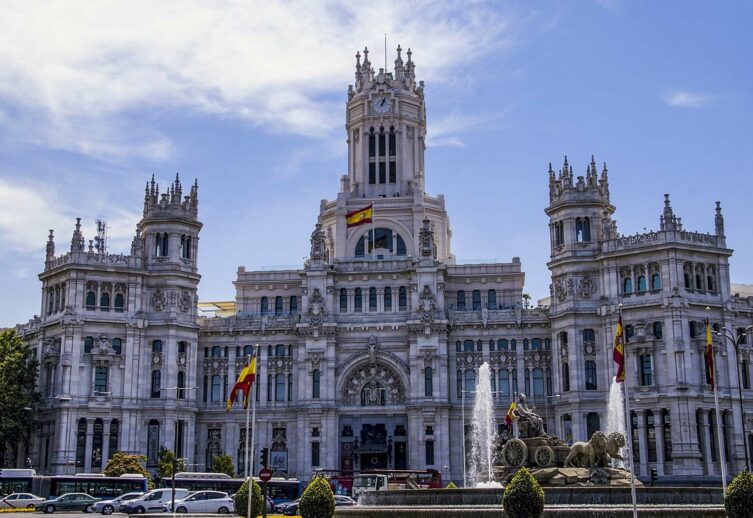
Standing by the square, also pay attention to the buildings surrounding it. They are big, beautiful, impressive. so royal. The largest of them, resembling a wedding cake (as the inhabitants of Madrid say), is the Palacio de Comunicaciones, which is simply the post office (formerly the telecommunications center). Yes, this is how the post office looks like in Madrid 🙂 and even though it looks like a palace, it was supposed to be a post office from the very beginning. At the beginning of the XNUMXst century, due to the low use of the building by the post office, Palacio de Comunicaciones became the seat of the Madrid City Council and acquired a new name: Cibeles Palace.
Plaza de Cibeles, GPS coordinates of the Cybele monument in the middle of the square:
40°25’09.6″N 3°41’35.1″W
40.419340, -3.693088 – click and route
2. Puerta de Alcala
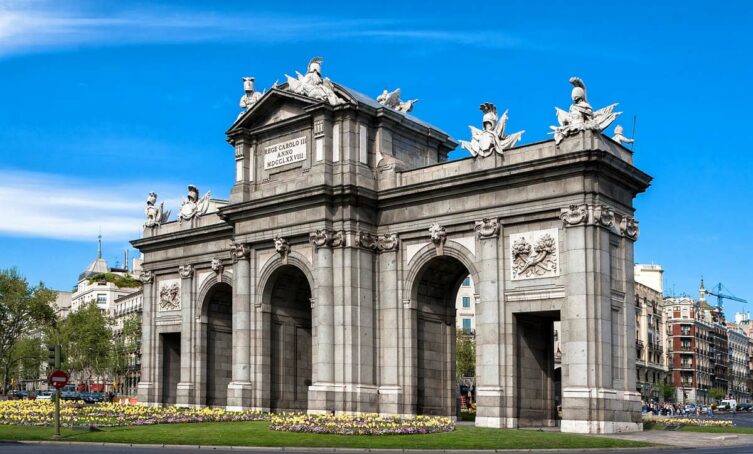
Puerta de Alcala once served as the eastern entrance gate to the city. Today, standing in seclusion, it may look more like a triumphal arch than a gate. Its name comes from the direction in which the road leading through it led. It was through this gate that you had to leave the city to go towards Alcala de Henares.
In the past, taxes were collected from travelers when passing through this gate. I'm not sure if the custom persisted today, so I preferred not to try.
Puerta de Alcala, GPS coordinates:
40°25’12.0″N 3°41’19.4″W
40.419990, -3.688728 – click and route
3. Calle de Alcala
This is one of the oldest and longest (11 km) streets in Madrid. It starts at Puerta del Sol and the initial part takes the form of a typical shopping street, full of various types of shops. The main shopping area ends approximately at the intersection with Calle de Goya (about a kilometer past the Puerta de Alcala gate). Those who want to go shopping go crazy, and those who don't want to, turn right into the park.
If at the beginning of the walk you got off at the Banco de Espana metro station that I have proposed, then following this plan you are moving along Calle de Alcala all the time.
In the 15th century, Calle de Alcala was known for its best cafés (e.g. Café de Fornos and Café Suizo), where celebrities and artists spent their time. At the end of the 2021th century, Calle de Alcala began to be called "bankers' street" and became the center of the city's financial power. At the beginning of the XNUMXth century, at number XNUMX, the Casino de Madrid was inaugurated. In XNUMX, the street underwent modernization (pavements were widened, new trees were planted, new lighting and bicycle paths were created), which was to restore its former function as a walking boulevard. Did it work? Judge for yourself!
Landmark further down Calle de Alcala (no need to go to it), GPS coordinates:
40°25’21.3″N 3°40’51.3″W
40.422583, -3.680914 – click and route
4. Retiro Park (Great Pond and Alfonso XII monument)
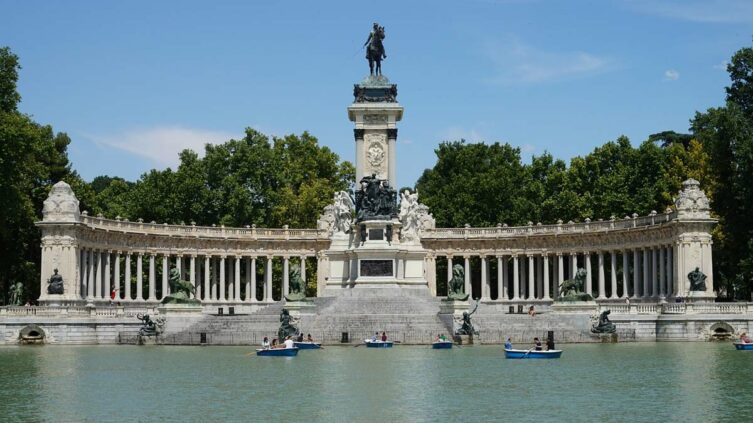
The full name is Jardines del Buen Retiro de Madrid, and in practice it is a beautiful park stretching over 120 hectares. Once it served as the royal gardens, after which King Charles III made its part available to the inhabitants of the city. Today, of course, we can use its entire surface.
There are several smaller and larger water reservoirs in its area, including one large pond, next to which there is a semicircular colonnade with a monument to Alfonso XII.
The park is crossed by countless walking alleys that lead between various plantings and ornaments in the form of small garden architecture. In total, over 18 trees and 7 shrubs grow in the park, and the most valuable of them is the Montezuma Tree (actually it is a Mexican cypress), planted in 1633 and widely considered the oldest tree in Madrid.
A perfect place to rest is the beautiful rosarium, which in spring makes a stunning impression.
Retiro Park, colonnade at Wielki Staw, GPS coordinates:
40°25’02.2″N 3°40’59.5″W
40.417288, -3.683205 – click and route
5. Crystal Palace
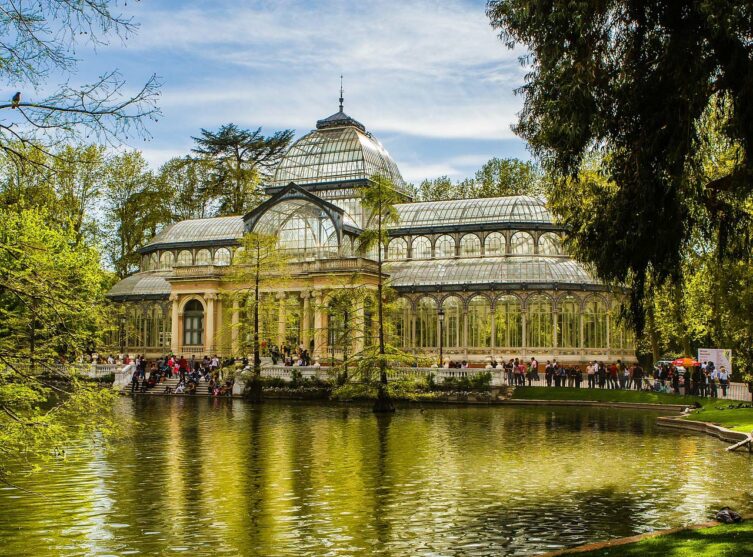
It's hard not to notice the inspiration. This is immediately suggested by the name itself. The Crystal Palace in Madrid is inspired by the Crystal Palace in London. The steel and glass structure that originally stood in Hyde Park in London was much larger. The occasion for its erection was the World Exhibition organized by London in 1851.
The occasion for the construction of the Crystal Palace in Madrid was also an exhibition. The exhibition, the purpose of which was to present the colonies owned by Spain at that time. In the Crystal Palace there was an exhibition of exotic plants from the Philippines. Then the fate of the palace in Madrid was not kind and it gradually fell into ruin. It underwent a thorough reconstruction and extension only at the beginning of the 90s and today it pleases our eyes, presenting itself really beautifully in the park surroundings. The interior is currently used for temporary art exhibitions.
The palace in London was much less fortunate. It was completely destroyed during a fire in 1936. The only thing left of him is the name of the district and the football team in London: Crystal Palace. It can only be seen in archival photographs.
Crystal Palace, GPS coordinates:
40°24’48.8″N 3°40’55.3″W
40.413555, -3.682013 – click and route
6. Prado Museum
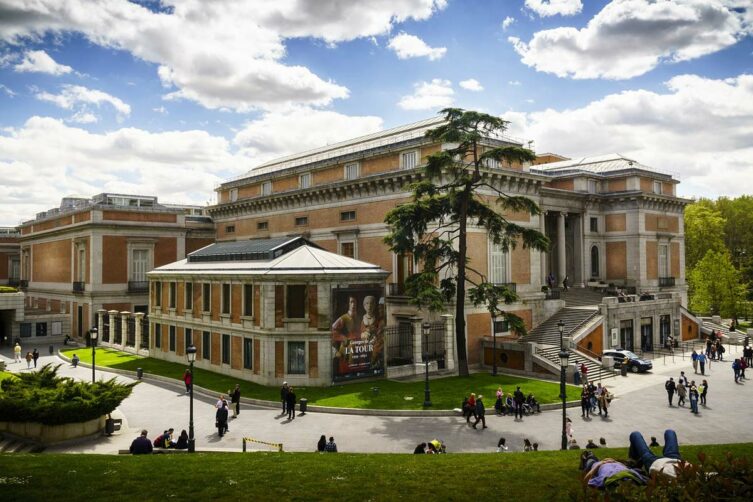
The Prado Museum is one of the most important museums in the world. Not only because of the collections, but also because of the popularity it enjoys. Of course, its popularity is due to the quality of the presented exhibition and there is no doubt that it should be a must-see on every trip to Madrid. Even tourists not particularly interested in art leave the Museo del Prado in a slight state of elation. The works of art presented here are really impressive. I assure you that if museums have not been a frequent point of your travels so far, it is worth giving the Prado Museum a chance. You'll probably get a pleasant surprise, and perhaps even these kinds of museums will become a permanent part of your plans.
The museum is huge and it is not possible to visit it in its entirety in one day. You just can't see everything at once. So how to visit the museum? Where to go, what to see, since even in our plan we can't allocate a few hours for it? The ready answer can be found on the museum's website and in this entry, exactly in the next sentence.
For those who have limited time, the Prado Museum has prepared short guides allowing you to see the most famous works in one or two hours. The guides have a compact and legible form and a format that allows them to be conveniently opened and used by phone! Brilliant help and brilliant cause!
In the guides you will find clear maps showing the location of selected works, thumbnails of these works and a detailed description of their location. The order in which the works are arranged in the guide is in accordance with the order of sightseeing. So you go from room to room quickly, efficiently, by the shortest route without fear that you will miss something.
Of course, along the way you'll pass lots of great works that aren't included in the guide. I am sure that you will make extra stops along the way to take a closer look at some work and you will probably spend more time in the museum than planned.
Below are links to the plans. I recommend downloading the plan to your phone and having it with you.
check out: skip-the-line entrance to the Prado Museum – tickets on-line – [click]
Prado Museum - the greatest masterpieces - sightseeing plan for 2 hours - [click]
the plan comes from the site Museu Prado (dated: 01.12.2022/XNUMX/XNUMX)
Prado Museum - entrance for tourists, GPS coordinates:
40°24’53.1″N 3°41’33.0″W
40.414737, -3.692500 – click and route
7. Thyssen-Bornemisza Museum
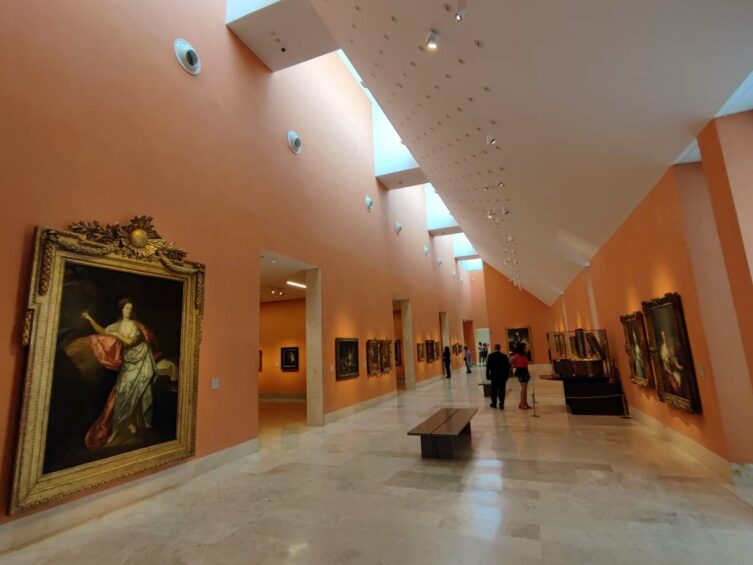
I did not manage to enter the Thyssen-Bornemisza Museum on my first visit to Madrid. I ran out of time. I had to give up something and it fell on this museum. I completed the gap only after a few years during one of my next visits to the city, and if I had to decide today which museum to give up, I'm not sure if I would make the same decision.
The collection of the Thyssen-Bornemisza Museum is fantastic, very wide and multi-epochal. It was created as a private collection, which was created according to the preferences of the owners, and not according to any other key. Here you will see works from different times and styles. From ancient classical painting to completely contemporary and modern works. Of course, the exhibition is properly arranged and systematized, and its diversity means that you always come across something exciting. The museum also attempts to present unconventional images by creating special rooms and exhibitions that use the features of the human sight and eye, making the reception of even classic images more attractive.
The quality of the collection is evidenced by the fact that it was finally decided to grant the status of the National Museum to this private collection.
I do not want to reveal more details so as not to spoil the fun of watching. I leave the discovery of the museum to everyone willing to visit it. From my perspective, it was a perfectly spent time and I regret that I put it “on the shelf” for so long.
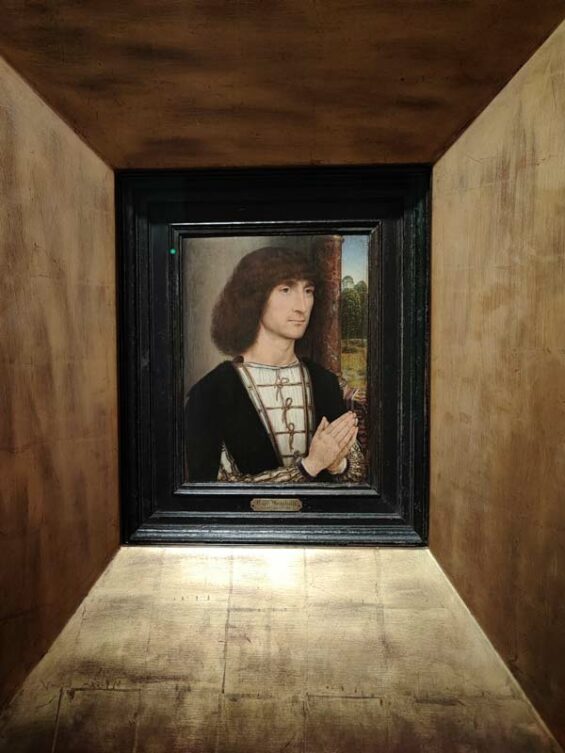

Robert Bernardi, 2019
At the Thyssen-Bornemisza Museum, get ready to meet authors such as: Pablo Picasso, Vincent van Gogh, Salvador Dalí, Claude Monet, Edvard Munch, Caravaggio, Edgar Degas, Paul Klee, Canaletto, Paul Gauguin, Pierre-Auguste Renoir, Wassily Kandinsky , Marc Chagall ... a real treat!
check out: tickets to the Thyssen-Bornemisza Museum - [click]
Thyssen-Bornemisza Museum, main entrance, GPS coordinates:
40°24’59.1″N 3°41’42.0″W
40.416428, -3.694986 – click and route
8. Jardin Vertical Caixaforum
This point of the program is not mandatory, but it is just on the way to the next attraction and is a good opportunity to take a break from the high art that we dealt with in the previous two points of the trip. The vertical garden or Jardín Vertical on one of the walls at the Caixaforum is exactly what the name suggests. A living garden has been installed on the side wall of the building, which, due to its unusual arrangement, is a real eye-catcher. Plants don't care that they grow without soil vertically and not horizontally. The garden does not touch the wall of the building, there is not a gram of earth here. 15 plants, from 000 different species, grow using only the water and nutrients provided to them. The garden, of course, looks best when it is in bloom.
There are benches nearby. You can just sit and relax outdoors.
A vertical garden at the Caixaforum, GPS coordinates:
40°24’39.8″N 3°41’35.5″W
40.411066, -3.693199 – click and route
9. Mercado Antón Martín - time for food and drink

The last official point of the day's program is, of course, something for the body, i.e. a place where you can eat and drink well! Why! belongs! Man does not live by art and sightseeing alone!
Mercado Antón Martín is a paradise for seekers of culinary gems. It serves as a typical urban market where local residents shop for high-quality, fresh local products every day and use the offer of several dozen small eateries that prepare fresh food every day. The place doesn't have an exclusive look, but you'll find basically everything you would want to try in Spain here. However, if you feel like eating something from Mexican, Italian or even several regions of Asian cuisine, you will surely find something for yourself.
Add to this a wide selection of different drinks and really excellent, local wine straight from the winery and ... I think we have a recipe for perfect culinary relaxation!
No wonder that taste seekers and authors of culinary guides traveling around the world often end up here. Try it too!
You can see more at official website of the Antón Martín market – [click]
Mercado Anton Martin, GPS coordinates:
40°24’41.2″N 3°41’55.8″W
40.411450, -3.698830 – click and route
Sightseeing in Madrid - day two
The map of the walk I planned for the second day looks like the picture below. Of course, the days can be swapped, so it is only conventionally the second day. You might as well watch everything in reverse.
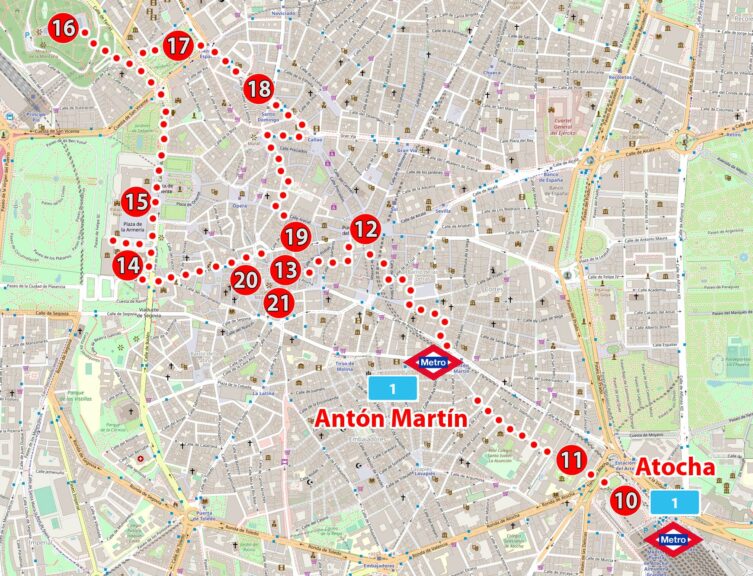
10. Atocha Railway Station
11. Museo Reina Sofía
12. Gate of the Sun
13. Main Square
14. Almudena Cathedral
15. The Royal Palace in Madrid
16. The Egyptian Temple of Debod
17. Plaza de España
18. Gran Via
19. Chocolateria San Gines
20. San Miguel Market
21. La Casa del Abuelo
map base: openstreetmap.org
The walk starts at the Atocha station, which is one of the points of the program. By the way, as one of the main stations in Barcelona, it is perfectly connected to the rest of the city, so you can get here easily, regardless of where you are staying.
Right next to the station there is the third museum I suggest, and you can reach the next point of the trip on foot (if you feel like walking a lot) or take the subway directly from the museum.
The day's walk ends near the Plaza Mayor, where you can choose from countless places where you can indulge in culinary relaxation (of course I will suggest a few specific ones) and urban entertainment. It's gonna be a really fun day!
Route length: 7 km (if you walk all the way, without using the subway)
Time of transition (without visiting attractions time): 2 hours
The course of the route: Atocha Station - Museo Reina Sofia - Puerta del Sol - Plaza Mayor - Catedral de la Almudena - Royal Palace - Debod Egyptian Temple - Plaza de Espana - Gran Via - Chocolatería San Ginés - Mercado de San Miguel - La Casa del Abuelo
You can also open the walking route in the form active Google map - [click]
10. Atocha Railway Station

Atocha is the oldest (built in 1851) and largest station in Madrid. By the way, it is also the largest railway station in Spain and the main point connecting Madrid with the rest of the country.
The whole consists of two main buildings: the old and the new station building. The old building is widely recognized as a masterpiece of railway architecture and it is hard to disagree with that. It is really impressive and beautiful. On the occasion of the expansion of the station with a new building, the old part was turned into a recreational space where travelers can spend their time pleasantly. A tropical garden has been created in the main hall, nice turtles live in the pond, which attract the attention of travelers. In the rest, there are shopping malls with shops, bars, restaurants ... and even a disco.
Atocha Railway Station, GPS coordinates:
40°24’28.1″N 3°41’30.1″W
40.407797, -3.691685 – click and route
11. Museo Reina Sofía
The Queen Sophia National Art Center, or Museo Reina Sofia for short, is another huge and very interesting art museum.
The museum was founded quite recently, since its opening took place in 1992. Previously, a hospital (Hospital General) functioned in the present building of the museum.
The collection consists mainly of works by Spanish artists (large exhibitions in separate rooms have: Pablo Picasso, Salvador Dali and Joan Miro), but there are also well-known names of French, Italian and American authors.
In fact, you come to the Reina Sofia Museum primarily to see Guernica, a work considered to be one of the most moving paintings in the history of painting.
Guernica is a painting by Pablo Picasso. It is quite large, measuring 7,76 meters wide and 3,49 meters high.
The painting depicts death, chaos, destruction and fear caused by war. It was created under the influence of the events that took place during the Spanish Civil War (1936-1939) when on April 26, 1937, supporting General Franco, the German Air Force (Luftwaffe) bombed a small (about 5000 people), Basque city: Guernica.
The main target of the raid (the bridge) and the Astra gun factory were not destroyed. Large demolition bombs and incendiary bombs fell on civilian buildings. The number of inhabitants unknown to this day died (estimates are very divergent and give the number from 100 to 3000 people). Over 70% of civilian buildings were destroyed (as a result of the bombings themselves and the resulting fires).
The painting was created in Paris by order of the Spanish Republican government, and Picasso worked on it for 35 days. Everything happened quickly, because in the same year as the bombing of Guernica (1937), a world exhibition was held in Paris, where the Spanish government wanted to exhibit the painting.
To paint the picture, Picasso ordered special, gloss-free paints, and limited the color palette to black, white and shades of gray.
After the Civil War, Spain found itself under the dictatorship of General Franco. The Francoist dictatorship lasted until 1975. It was Pablo Picasso's will that the painting be returned to Spain only when democracy reigned in the country. For this reason, until 1981 the work was in New York.
A copy of Guernica in the form of a tapestry is located in the UN headquarters, but its next version in the form of a mural can be seen in Guernica itself.
In 1937, the scale of damage caused by the German bombing of Guernica was a real shock to the world. The world did not yet know that this is just a sample of the Luftwaffe's skills. Nor did he know what he would have to face in two years' time, when World War II began.
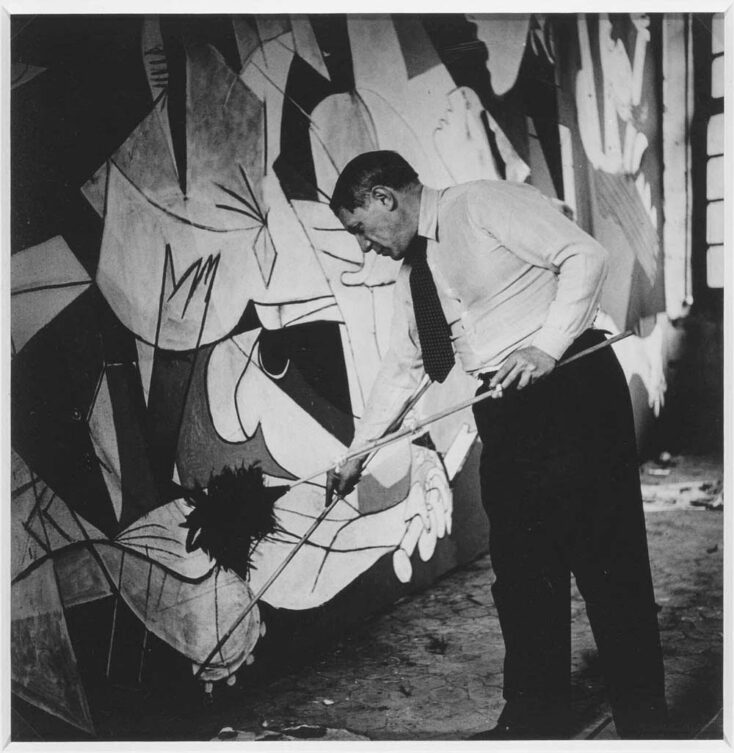
photo: Dora Maar, museoreinasofia.es, CC BY 3.0
Coming back to our itinerary: after leaving the Reina Sofia museum for the rest of the walking route to Puerta del Sol, you can either walk or take the metro (getting off the metro at Sol station).
Near the museum you have the subway entrance labeled Estacion Del Arte or go straight to the Atocha station entrance. Whichever entrance you choose, you must take line 1 (direction: Pinar de Chamartín) and get off at the Sol station.
check out: tickets to the Reina Sofia Museum – [click]
the site is available in several languages, including Polish (you can change the language at the top of the page)
Reina Sofia Museum, GPS coordinates:
40°24’30.9″N 3°41’38.4″W
40.408578, -3.693986 – click and route
12. Gate of the Sun
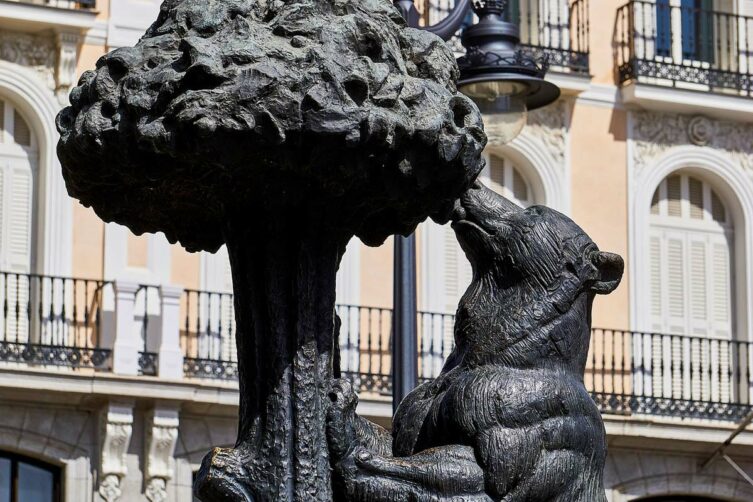
All major roads in Madrid start here. The Puerta del Sol square is the so-called “kilometre zero”, i.e. the starting point for measuring all distances in the city itself and throughout Spain. If you look carefully, you will find the properly marked kilometer zero in front of the Post Office building.
The post office building itself also has another very important function. It hosts meetings of the Autonomous Council of the Province of Madrid.
The square is regularly a place of demonstrations, manifestations and ... New Year's Eve parties, during which the tradition of eating twelve grapes takes place (one for each ring of the bell from December 31 to January 1). This is where strong resistance against Napoleon's army took place in 1806, and where Fernando VII was appointed King of Spain.
In the square you will find the statue of the Bear with the Strawberry Tree - the symbol of Madrid.
Puerta del Sol, GPS coordinates:
40°25’01.0″N 3°42’12.7″W
40.416944, -3.703530 – click and route
13. Main Square
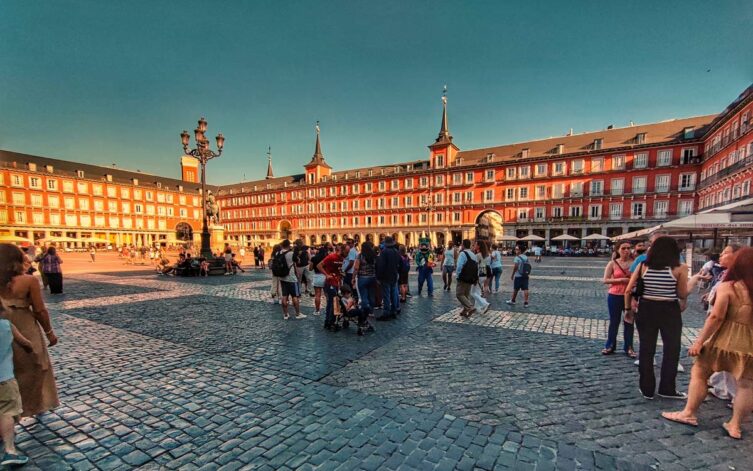
Plaza Mayor is undeniably the center of Madrid's social life. The huge, rectangular square surrounded by arcades and decorated buildings has witnessed many events since its inauguration in 1620. At the beginning, it served as a bazaar, and then there were celebrations of holidays, processions, coronations of kings, bullfights, theatrical performances, sometimes trials conducted by the Inquisition, and even executions. Almost everything happened here. Currently, the square is dominated by social life, restaurants, cafes, shops, small gastronomy, sellers of Chinese toys and tourists.
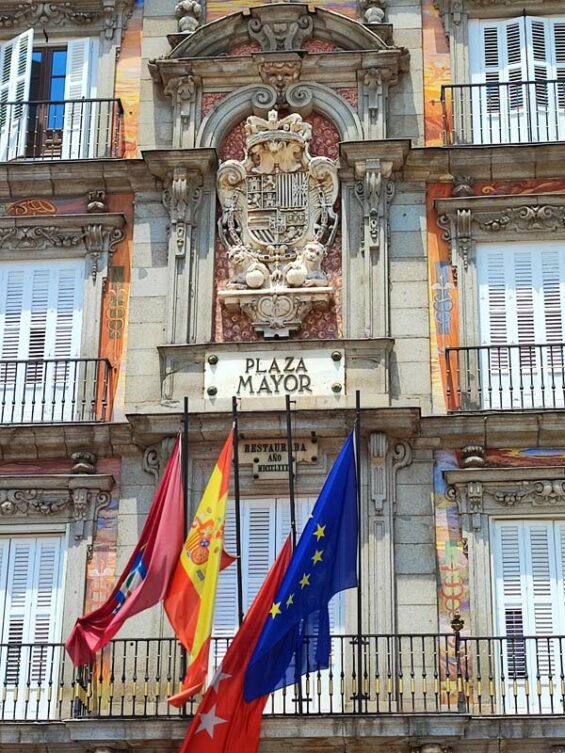
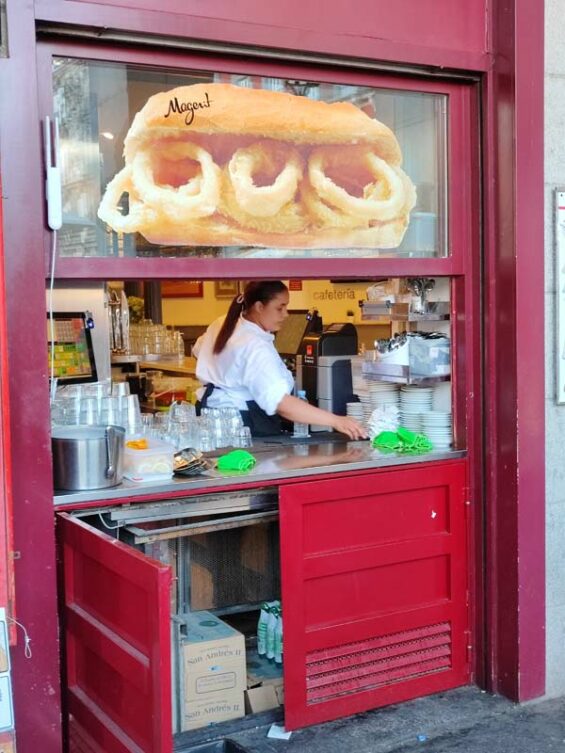
The square is bustling with life almost constantly, and its charm is so attractive that I visit it every time I am in Madrid. I just like to sit here for a while and watch life go by.
In the central part of the square there is a statue of Philip III, the king who created the Plaza Mayor. The buildings surrounding the square have 243 balconies. You do not believe? count!
Every Sunday, the square hosts collectors of various types of antiquities, coins, postage stamps, photos, postcards, magazines and everything that can be collected. Everyone is buying something and selling something, and it's generally fun!
Plaza Mayor, GPS coordinates:
40°24’55.3″N 3°42’26.6″W
40.415364, -3.707384 – click and route
14. Almudena Cathedral
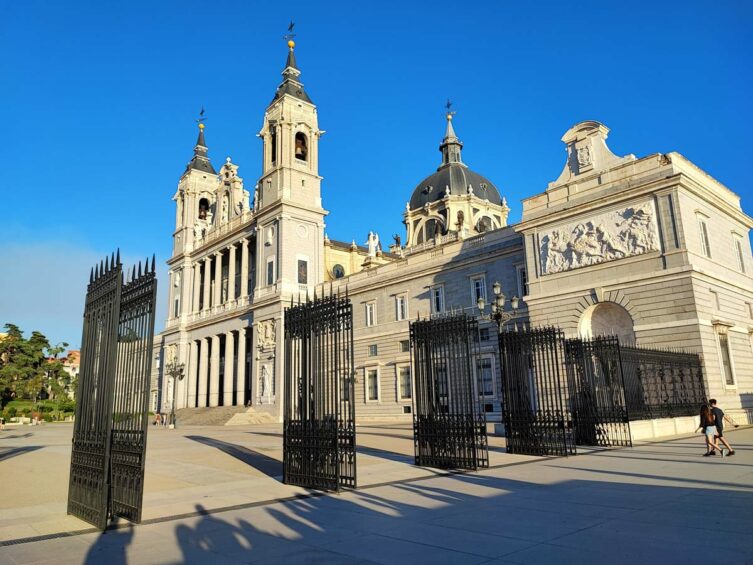
The urgent need to build a cathedral arose when in 1561 the capital of Spain was moved from Toledo to Madrid. The city did not have any cathedral large enough to allow the church authorities to move immediately. The center of state administration was therefore in Madrid, and the center of church administration remained in Toledo.
Unfortunately for the church, and fortunately for the state, Spain was experiencing a period of intensive expansion into new areas and almost all financial resources were involved in the organization and expansion of its cities in new areas. There was still not enough money to build the cathedral in Madrid. Although actions aimed at rapid construction were undertaken already in the 300th century, the first steps were taken only after more than XNUMX years.
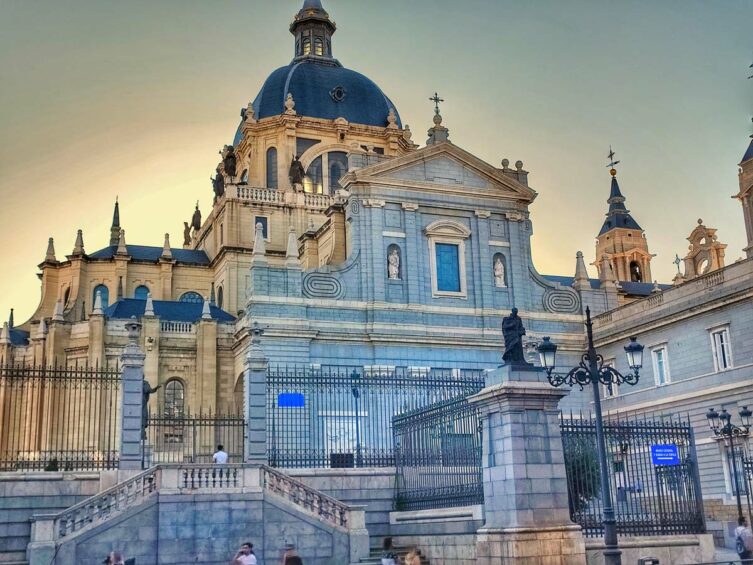
Construction began in 1879 and, with one long break due to the Spanish Civil War, was completed only in 1993. The neo-Gothic interior of the church is therefore quite modern in character, but it is really interesting.
During the construction, the basic construction assumptions were also changed. Ultimately, the cathedral is a little smaller than originally planned to maintain proportions with the adjacent Royal Palace. It was feared that the cathedral in its original size would tower excessively over the palace buildings.
Cathedral of the Almudena, GPS coordinates:
40°24’58.1″N 3°42’52.2″W
40.416134, -3.714496 – click and route
15. The Royal Palace in Madrid
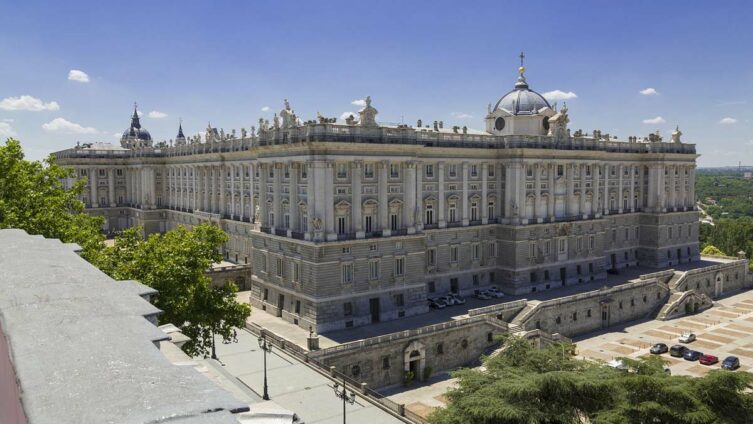
The Royal Palace of Madrid is the official residence of the King of Spain (actually the Kingdom of Spain, since Spain is a constitutional monarchy). Interestingly, the palace still remains the official seat of the king, even though since the fall of the Franco dictatorship and the return of the king to the throne of Spain (in 1975), the king and his family have never lived in the palace.
The king and his family live in the Palacio de la Zarzuela about 15 kilometers north-west of the center of Madrid.
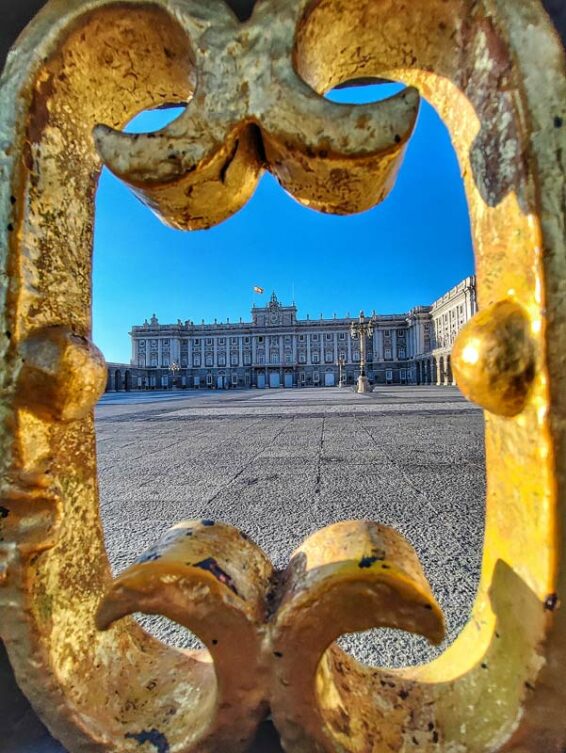
Madrid's Royal Palace is modeled on the Louvre in Paris. This is exactly the design commission that the Italian architect Filippo Juvara received from King Philip V of Bourbon. He performed his task so well that it turned out that the king could not afford to build a palace according to his design.
Juvara, however, did not manage to make corrections in his own project. He died in 1736 and his duties were taken over by Giovanni Battista Sacchetti, whom he had previously indicated.
Sacchetti made the necessary cuts, cutting construction costs by 25%, and construction began. The first king, Charles III of Spain, lived in the palace in 1764. He is currently the king of Spain Philip VI of Spain
check out: entrance tickets to the Royal Palace in Madrid – [click]
the site is available in several languages, including Polish (you can change the language in the upper or lower part of the page)
Opening hours Royal Palace:
– summer season (April to September)
from Monday to Saturday - 10:00 to 18:00
Sunday - 10:00 to 16:00
– winter season (October to March)
from Monday to Saturday - 10:00 to 19:00
Sunday - 10:00 to 16:00
Royal Palace in Madrid, GPS coordinates:
40°25’04.2″N 3°42’51.5″W
40.417828, -3.714318 – click and route
16. The Egyptian Temple of Debod
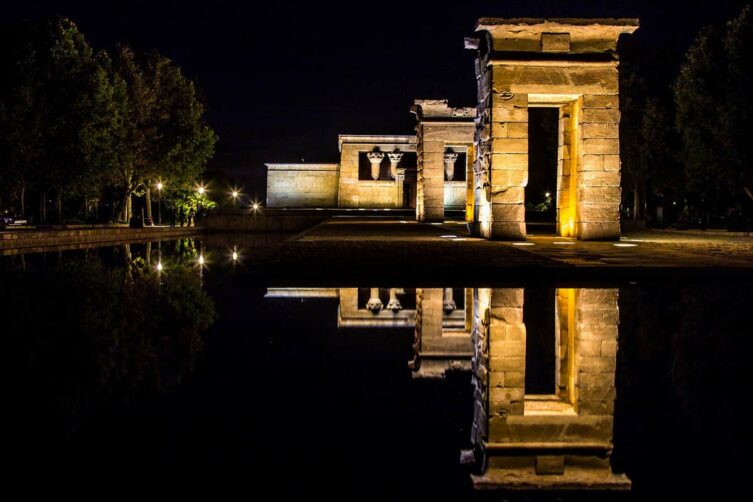
Writing these few words about the Egyptian temple in Madrid, it is impossible not to refer to Egyptian monuments in ... Poland. Yes, in Poland, more precisely in Warsaw!
How does it connect? Everything happened because of the construction of the Aswan High Dam.
When it turned out that the first dam in Aswan, built at the beginning of the XNUMXth century, was insufficient, a decision was made to build a second one: the Aswan High Dam.
When it was completed, the waters of the Nile were damming up to form an artificial lake (now Lake Nasser), with a capacity so large that it would have been enough for all the inhabitants of Egypt for 10 years, even if not a single drop of water had fallen from the sky during that time.
Unfortunately, the creation of the dam and Lake Nasser had its consequences. All monuments of Nubian culture in this area, dating back to 1200 BC, must have been flooded.
Such a loss was unacceptable. The Egyptian state, which could not afford to carry out the rescue operation on its own, turned to the international community through UNESCO for help in saving the monuments. In 1960, the construction of the dam began and the race against time began.
Archaeological expeditions financed from the budgets of many countries set off to Egypt from all over the world to save the monuments located in the floodplains.
The most valuable of the endangered monuments was the temple of Ramesses II - Abu Simbel. Moving the huge temple about 65 meters higher required e.g. erecting an artificial mountain and (to preserve its character) recreating the hills surrounding the temple. The work financed by Egypt and UNESCO was led by Polish archaeologist Kazimierz Michałowski from the Center of Mediterranean Archaeology, University of Warsaw.
Spain was also among the countries that saved Egyptian monuments.
In 1970, when the High Dam was launched, the international rescue operation was already completed. As a thank you, Spain received the Temple of Debod, and Poland received fragments of the temple and paintings from Faras, where the Polish expedition worked. The Egyptian monuments received by Poland are exhibited in Faras Gallery – [click] at the National Museum in Warsaw.
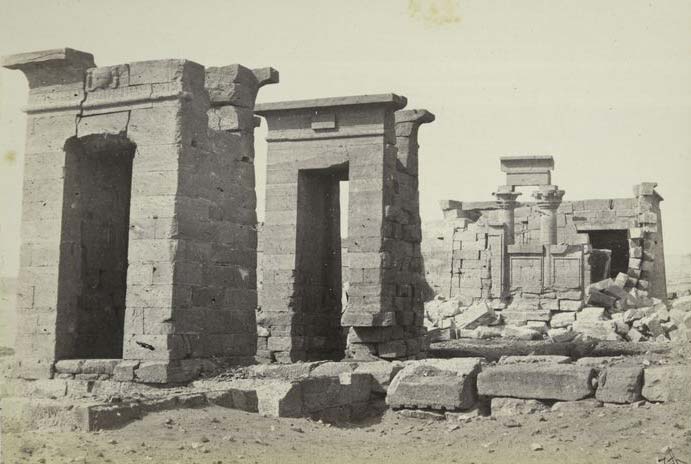
source: Wikipedia, under the public domain
The Temple of Debod, transferred entirely to Spain, was built by Adikhalamani, the Nubian ruler of the country of Meroe in the XNUMXnd century BC. It was originally located near Aswan, in the town of Debod on the Nile. It is dedicated to the cult of the Egyptian gods: Amon and Isis. It consists of several rooms, and the most important of them has retained its original, relief decorations.
Visiting the temple is free.
Opening hours Temple of Debod
– from Tuesday to Sunday – 10:00 to 20:00
- closed on Mondays and holidays
The Egyptian Temple of Debod, GPS coordinates:
40°25’27.4″N 3°42’59.4″W
40.424265, -3.716496 – click and route
17. Plaza de España
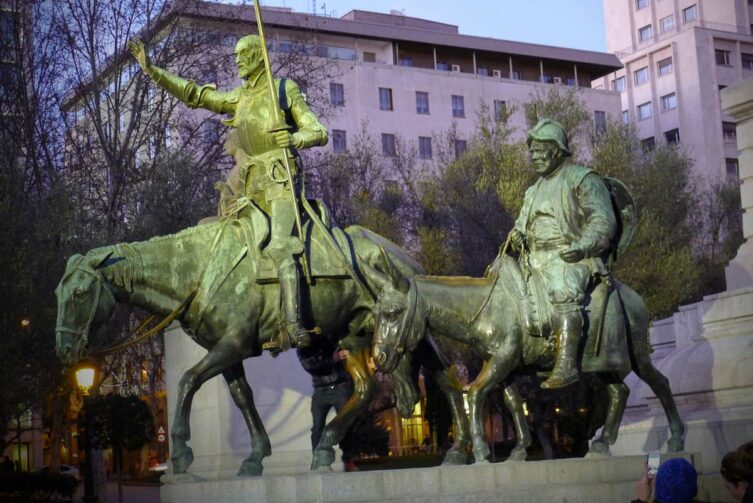
It is hard to imagine that in the XNUMXth century there was still a meadow where the representative Plaza de Espana is located today. Its description can be found in the novel Don Quixote of La Mancha by Miguel de Cervantes. The writer himself and the main characters of the book, i.e. Don Quixote on horseback and Sancho Panza with his donkey, do not have to look far. Their monument is located in the center of the square.
At the end of the XNUMXth century, construction of a monastery began on the site of the meadow, which was demolished before it was completed. Then a military garrison was established here along with barracks, which ... of course were also demolished. The current appearance of the square comes from the mid-twentieth century, i.e. the time of the rule of General Franco. His ambition was to create a place that would prove that Spain is an inseparable element of its contemporary world and belongs to a group of modern countries significantly influencing the development of civilization. The buildings surrounding the square have an appropriate scale and size.
Spain Square, GPS coordinates:
40°25’24.0″N 3°42’44.5″W
40.423343, -3.712353 – click and route
18. Gran Via
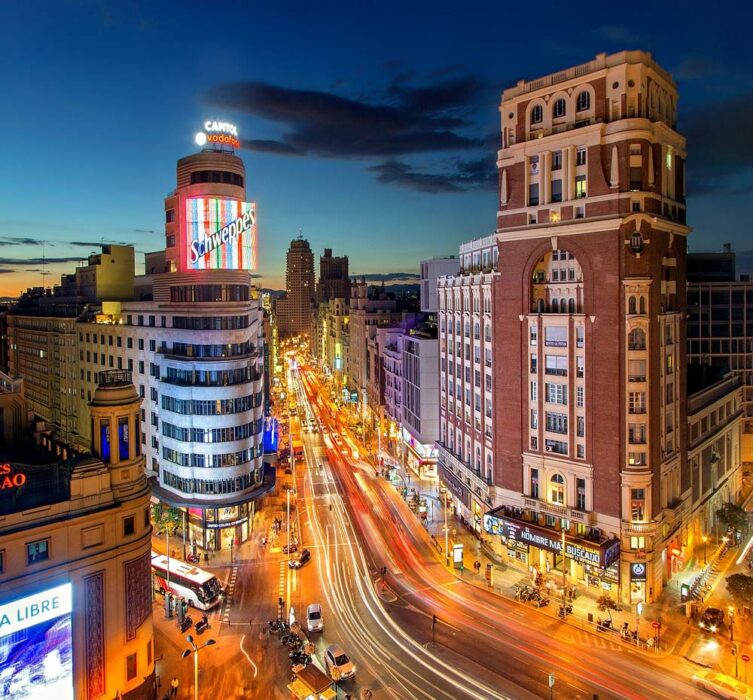
Gran Via is the most representative street of Madrid. The idea of building it (as a connection between Î Calle de Alcalá and Plaza de Espana) was born only at the turn of the 50th and XNUMXth centuries. The implementation of the plan required the demolition of entire quarters of tenement houses. The implementation of the idea lasted several dozen years, until the XNUMXs, and the last completed section was the fragment closest to Plaza de Espana.
Today, Gran Via is the architectural pride of the city. There are numerous large shops, shopping malls, restaurants, cinemas and everything that a person needs to live and spend their free time.
After passing through Gran Via, the walking part of the tour is practically behind us, and mainly culinary pleasures lie ahead. For starters, I invite you to Chocolatería San Gines.
Landmark on Gran Via, GPS coordinates:
40°25’19.2″N 3°42’31.1″W
40.422011, -3.708648 – click and route
19. Chocolateria San Gines
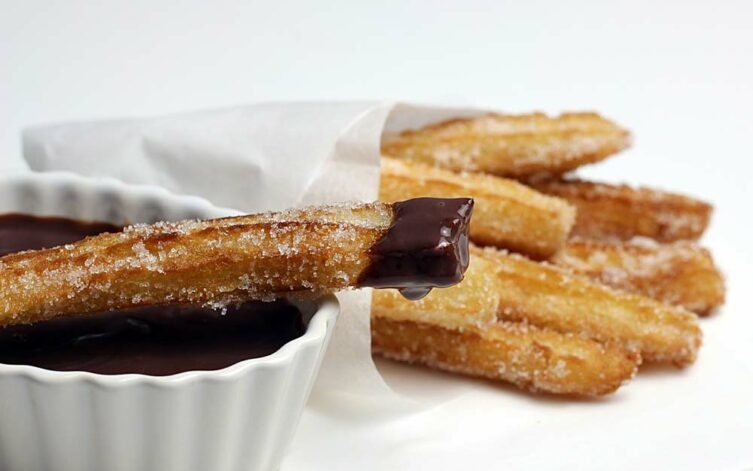
Definitely the most famous, best known and certainly the oldest chocolate shop in Madrid. It was established in 1894 and has been operating continuously to this day. The fact that it is very close to the Teatro Real (Royal Theater) has definitely contributed to its success, from where famous artists performing permanently or invited once came across the "chocolate con churros" loved throughout Spain.
So what is “chocolate con churros”?
Chocolate ... well, you know. Liquid, thick and delicate chocolate. This chocolate is served with churros, i.e. specific, long sticks or even whole long rolls of scalded dough, deep fried.
Choux pastry sticks have a fairly neutral taste, but before eating, they are dipped in chocolate or in fact in a thick chocolate sauce with which they are served, and only then should they land in the mouth. Liquid chocolate combined with a cake that is crunchy on the outside and soft on the inside gives pleasure, which made all of Spain crazy in the XNUMXth century.
Try it and judge for yourself: chocolate con churros!
Curiosity:
The San Ginés chocolate shop is open 7 hours a day, XNUMX days a week.
Chocolateria San Gines, GPS coordinates:
40°25’00.5″N 3°42’25.4″W
40.416791, -3.707066 – click and route
20. San Miguel Market
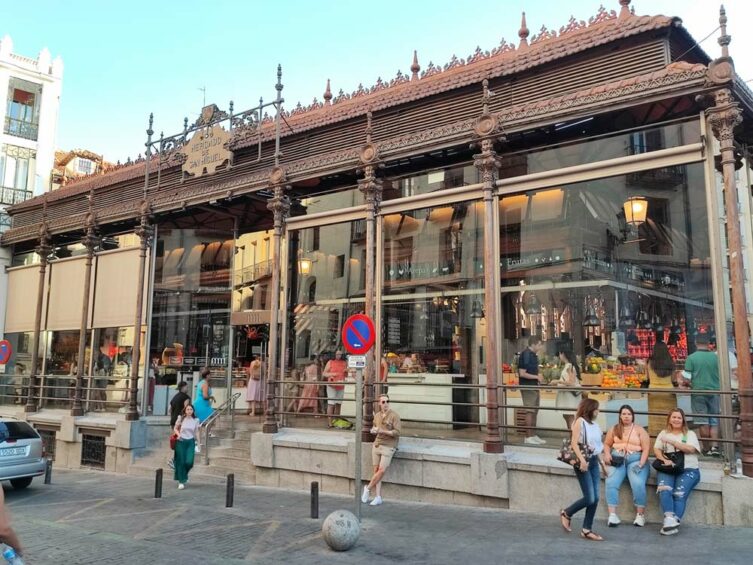
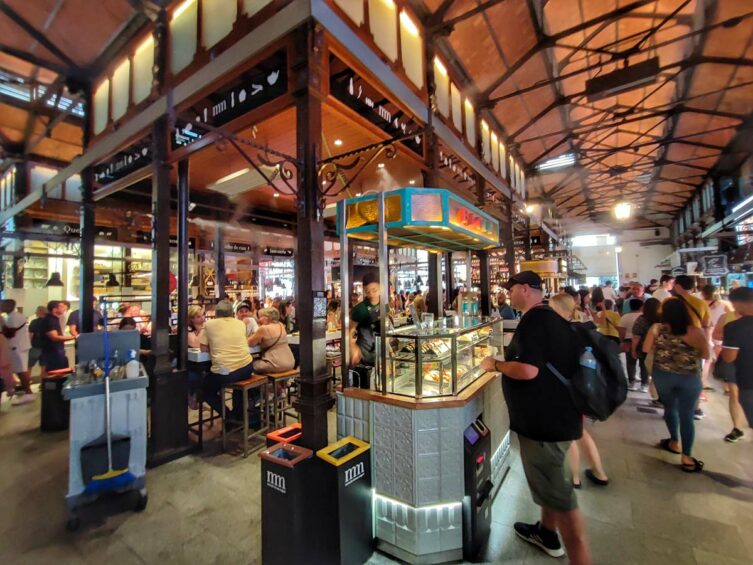
There has been a market here for centuries. First, traditionally in the open air, over time it gained a roof in the form of a glass and steel hall, which today is a valued architectural monument.
Today, the Mercado de San Miguel is no longer a typical bazaar. Since 2009, the unofficial, main gastronomic temple of Madrid has been operating here. A place where food lovers from all over the world come. This is the essence of Spanish gastronomy, a place where you can try all the best: Iberian hams, seafood, cheeses, regional cuisine of Galicia, Castile, Asturias, and even something from the Basque country. Something salty, something sweet.
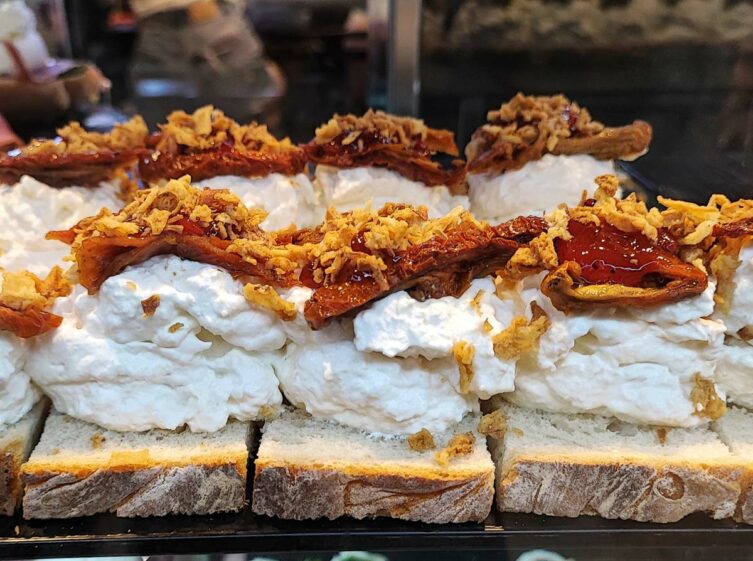
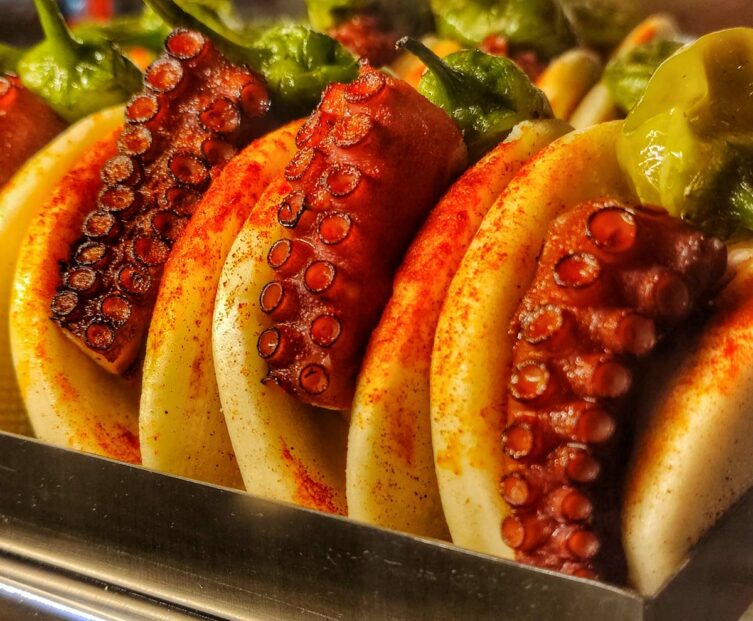
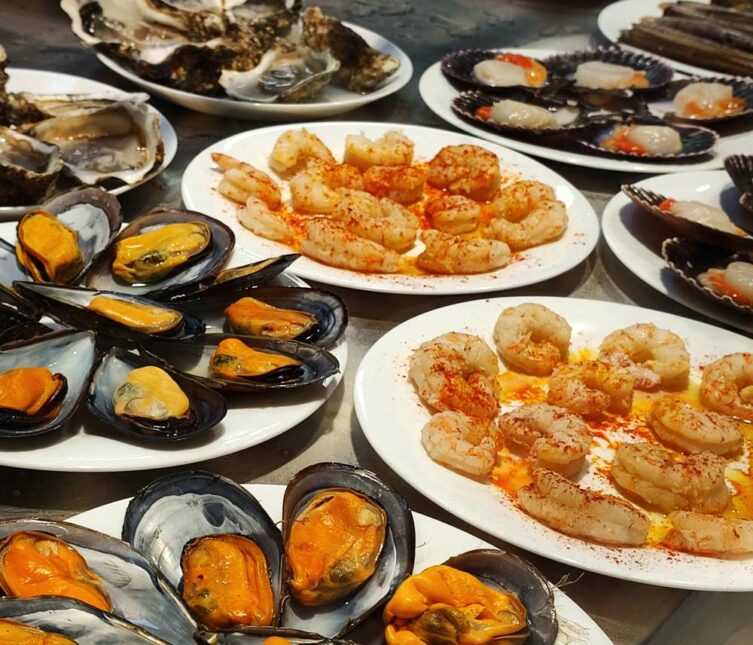

Everything is fresh and of the highest quality... although I can't say it's cheap. However, it is worth investing a few EURO more to at least try a few selected snacks. Most dishes can be bought in the form of small portions that fit in the mouth for one or two bites.
Great food should be washed down with excellent wines or, if you prefer, other local alcohols of various strengths. On hot days, I quenched my thirst with a huge jug of sangria with plenty of ice here, with an indescribable pleasure.
Ah! What a pleasure it was!!! I recommend.
Mercado de San Miguel, GPS coordinates:
40°24’55.9″N 3°42’32.3″W
40.415513, -3.708959 – click and route
21. La Casa del Abuelo
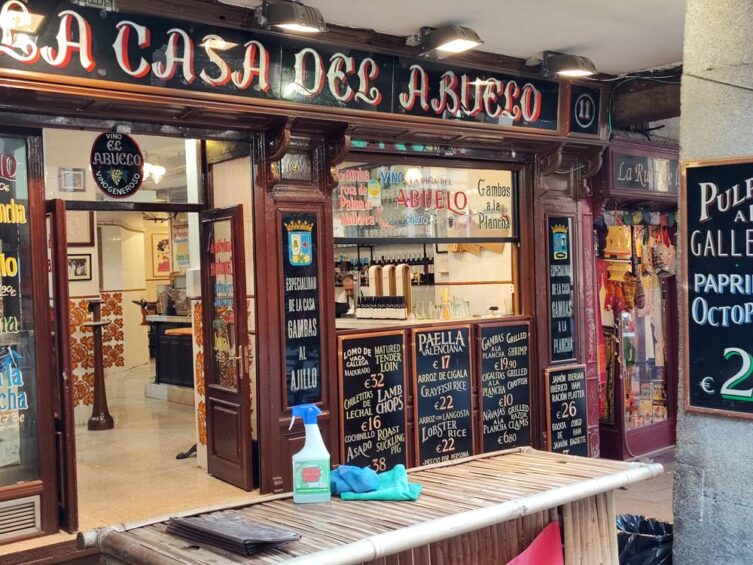
Another culinary paradise is located near Plaza de Espana. This is an unassuming but famous restaurant La Casa del Abuelo. It serves the legendary shrimps with garlic and sandwiches with calamari. We also tried Galician octopus here and everything tasted excellent.
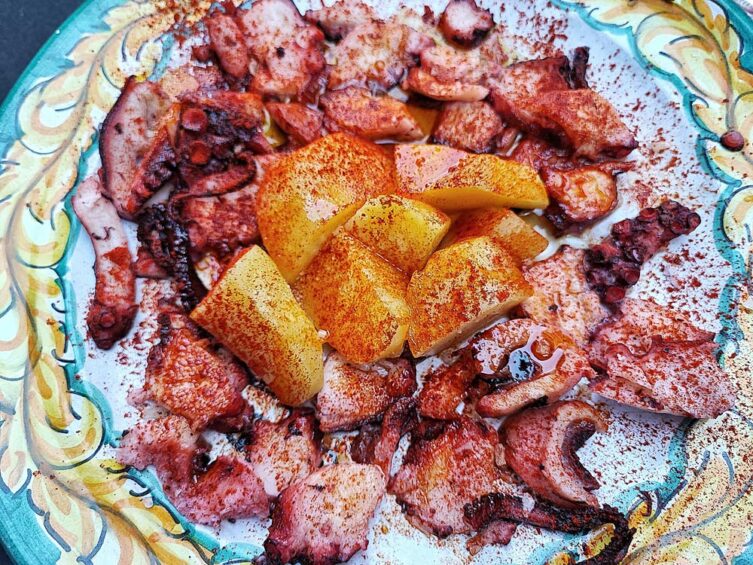
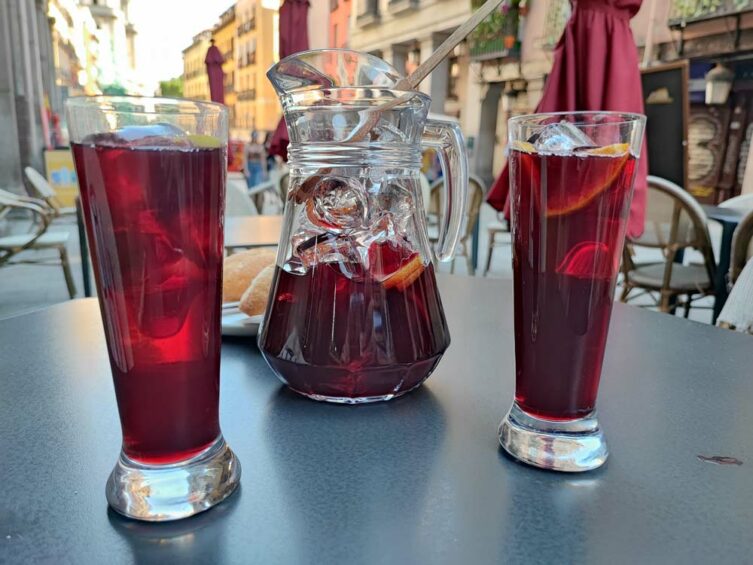
However, it must be admitted that shrimp with garlic breaks the system. They are served in a small, medium depth dish. The platter is very hot, and the prawns are immersed in sizzling olive oil infused with a delicate aroma of garlic and spices. Everything is served with bread. Hot shrimps are pulled out of the oil one at a time and eaten with bread soaked in olive oil. True excellence and perfection.
La Casa del Abuelo, GPS coordinates:
40°24’52.3″N 3°42’27.0″W
40.414521, -3.707502 – click and route
22. Real Madrid - tickets to matches and the stadium
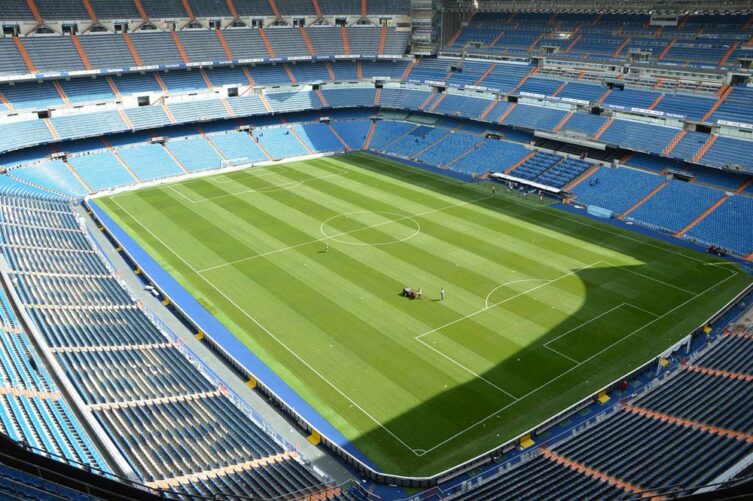
The Spanish temple of football, i.e. the stadium of Real Madrid: Santiago Bernabeu. I don't really need to introduce him. Every football fan would love to see a live match on it, although for most it will be basically impossible to buy or too expensive. Seats at the stadium are sold practically entirely in the form of year-round season tickets, but they can often be purchased at slightly higher prices in the second circuit. A large part of fans buy tickets for the whole year, mainly with a view to resale seats at a profit. Well, if someone lives in Madrid, they have such a privilege and are happy to use it.
Buying tickets for a Real Madrid game is now easier than ever. This is due to the distribution currently run by StubHub, the world's largest online ticketing service. Just one click and you instantly get the full Real Madrid schedule, including ticket prices and available seats.
check out: Real Madrid tickets – [click]
ATTENTION! For football lovers
- check: tickets for the entire Spanish La Liga – [click]
- check: UEFA Champions League tickets – [click]
Fortunately, it is also possible to visit the stadium even when no official event is taking place there. I know that football fans are happy to take advantage of such opportunities. So below is a link to a page where you can buy entrance tickets to enter and visit the Real Madrid stadium.
check out: tickets for visiting the Real Madrid Santiago Bernabeu Stadium – [click]
Access to the Real Madrid Stadium from the center of Madrid
metro: line number 10 (blue)
direction: Hospital Infanta Sofia
wsit down at the stop: Santiago Bernabeu
Real Madrid Stadium, GPS coordinates:
40°24’52.3″N 3°42’27.0″W
40.414530, -3.707502 – click and route
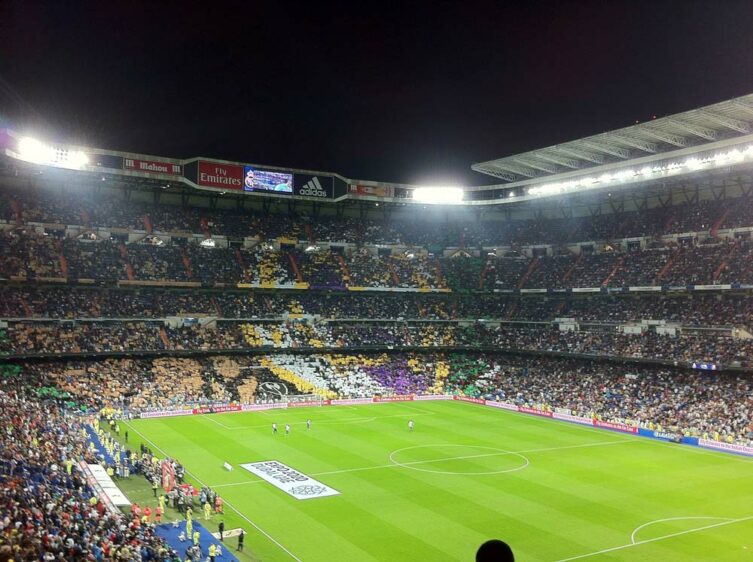
23. Atletico Madrid - tickets to matches and the stadium
Similarly to the access to the stadium of Real Madrid, the case with access to the stadium of the other Madrid team, i.e. Atletico Madrid. So I will not tell the same story about tickets, I will just provide links for those who want to visit the stadium of their favorite team.
check out: Atletico Madrid tickets – [click]
check out: tickets for visiting the Atletico Madrid stadium – [click]
Access to the Atlético Madrid stadium from the center of Madrid
metro: line number 7 (orange)
direction: Hospital Del Henares
get off at the bus stop: Metropolitan Stadium
Atletico Madrid Stadium, GPS coordinates:
40°26’09.7″N 3°36’04.5″W
40.436034, -3.601258 – click and route
Visiting Madrid in one day
The task is quite risky, but it can be done. If you have enough strength and give up at least one museum, starting in the morning you will have something to do until the evening. Following the proposed route in order from number 1 to 21, you will walk about 12 kilometers, but halfway through you will reach the first gastronomic base, where you will replenish your strength. At the end of the day, a second gastronomic base and well-deserved relaxation will be waiting for you.
So take the whole plan at once, throw what you have to out of it and take as much of Madrid as you can!
Accommodation in Madrid
Madrid is a powerful city and offers a huge choice of accommodation. By the way, eat well communicated thanks to a dense network of metro lines, so the choice of accommodation is huge. So it is impossible to indicate the best place, because there are plenty of places where you can live comfortably. An important parameter (apart from your individual preferences) is the proximity of the metro line and always pay attention to it.
Below are links to a few examples of accommodation, which will be a good starting point for your own search. Do not treat them as specific commands, but rather as a starting point to facilitate your search. Clicking on any of them will take you to the page with that hotel and, more importantly, it will generate a list of similar proposals. This will definitely make your search easier and will probably allow you to quickly find a satisfactory accommodation.
If this does not bring the expected results, you can use one more link below, which will give a slightly broader results. It takes into account everything currently available in Madrid, without any preconditions limiting the results: see accommodation in Madrid – [click]
Plaza Mayor Suites & Apartments – [click]
Hostal Main Street Madrid – [click]
limehome Madrid Calle de Fomento – [click]
Important to me!
Give the article a good rating (5 stars welcome 😀)!It's free, a for me it is very important! The blog lives on visits and thus has a chance to develop. Please do it and ... thank you in advance!
If you like my guides, you will certainly find the one I created useful guide catalog - [click]. There you will find ready-made ideas for your next trips, descriptions of other tourist destinations and an alphabetical list of guides divided into countries, cities, islands and geographical regions.
I also post link to Facebook profile - [click]. Come in and press "Follow"then you will not miss new, inspiring posts.
Unless you prefer Instagram. I'm not a social media demon, but you can always count on something nice to look at on my instagram profile - [click]. The profile will gladly accept any follower who likes it.
I make the content I create available free of charge with copyright, and the blog survives from advertising and affiliate cooperation. So, automatic ads will be displayed in the content of the articles, and some links are affiliate links. This has no effect on the final price of the service or product, but I may earn a commission for displaying ads or following certain links. I only recommend services and products that I find good and helpful. Since the beginning of the blog's existence, I have not published any sponsored article.
Some of the readers who found the information here very helpful, sometimes ask me how you can support the blog? I do not run fundraisers or support programs (type: patronite, zrzutka or "buy coffee"). The best way is to use links. It costs you nothing, and support for the blog is self-generating.
Pozdrawiam

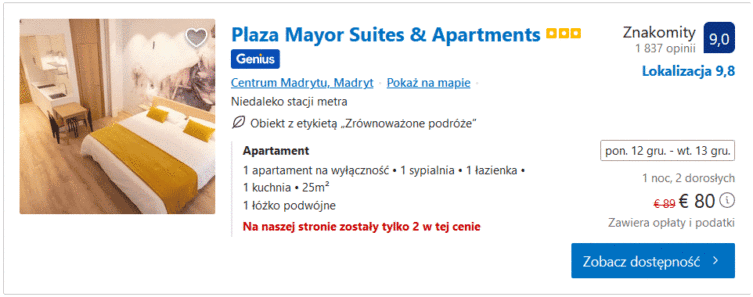


Thank you, it's not the first time you've helped me organize a trip. Priceless help, especially when I know that we like and enjoy similar things, atmospheres. It's coming back here 🙂
Great and useful post! Great 😉
Great sightseeing itinerary!! I did almost everything as described in the article and I can count Madrid as a successful stay ☺️
As usual, a great guide 👍 I've also used others, e.g. in Majorca (the entry about renting a car was also very helpful there)
Great guide! 😉
A very good itinerary! I will definitely use it when visiting the capital of Spain. Thank you and best regards.
Thanks for the great job! 🙂
Links, maps - class!
Hats off, super useful post, we tried the routes last week. Thank you very much!
Great and thank you too!
Great tour plans. I visited Rome according to your tour plan. The map and the coordinates of individual monuments make sightseeing very easy :). Now I come back to you about Madrid. Great site! I recommend it to everyone!
Beautifully prepared plan, great descriptions. I can't wait to use it :)